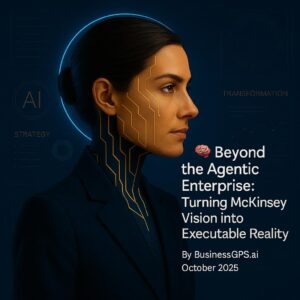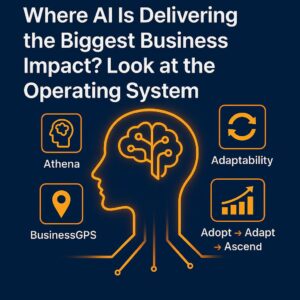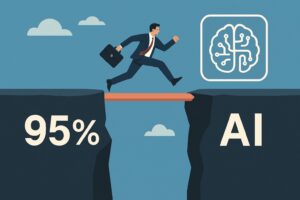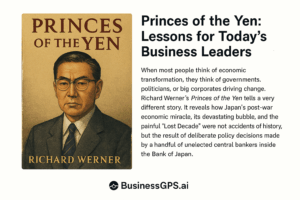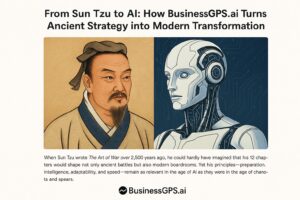
Harness AI to Master Ambidextrous Leadership & Succeed In Your Digital Transformation Ambition
How a bold management philosophy, augmented with AI, is the key to unlocking your technology-driven change ambitions.
In an era of rapid digital transformation, organizations need leaders adept at managing the present and the future. The eFinity framework and artificial intelligence (AI) offer a powerful combination to equip them with a systematic way of evaluating, navigating, and making decisions that drive organizational ambidexterity. AI is not just a tool but a guide — a mentor to help leaders ask the right questions, consider the broader implications of their decisions, and find innovative solutions. Unlock the potential of this powerful combination with Dr. Alex Turing — AI’s persona — and embark on your path to digital transformation success.
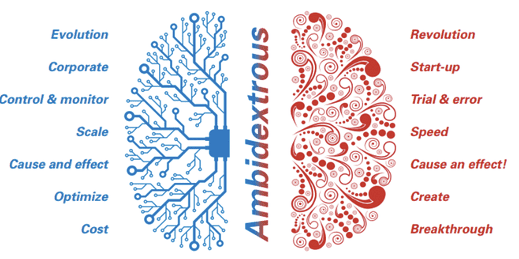
Illustration of an ambidextrous mindset (Lerner et al. 2018)
Why We Need to Change the Way We Change
In today’s increasingly complex, fast-paced, digitally augmented, and connected business arena, the ability to master business technology change to remain in equilibrium, fully engaged, and in constant flow and connection with markets, eco-systems, and stakeholders is THE essential capability for individuals, teams and organizations to secure their respective long term digital-era success.
This trend is presenting business leaders with a compounding challenge. Many people, teams, and organizations need help to bridge this data and technology-driven business chasm. While technology continues to evolve at a pace exponentially, the ability to absorb this volume and magnitude of change is difficult for individuals and organizations alike.
This is not a new or unknown problem; it’s one; however, that’s getting worse. Culture and adoption remain the biggest hurdle to digital transformation. In the latest industry benchmark survey, co-authored by Thomas Davenport, which I have been following since its inception in 2012, with all the good intentions, all the fantastic innovations and advances of the past decade and months, the message from the survey is clear:
1) Analytics AI and Data are essential capabilities — now more so than ever
2) Investments continue at pace, with a focus on capturing business value
3) Challenges with cultural adoption remain high and are not improving
DATA AND ANALYTICS LEADERSHIP ANNUAL EXECUTIVE SURVEY 2023
Becoming data-driven and building a data culture remain aspirational objectives for most organizations — Just 23.9% of companies characterize themselves as data-driven, and only 20.6% say that they have developed a data culture within their organizations, reflecting that becoming data-driven is a long and difficult journey that organizations increasingly recognize playing out over years or decades.
Cultural factors continue to be the greatest obstacle to delivering business value from data investments — The vast majority of data leaders — 79.8% — continue to cite cultural issues — organizational receptivity to change and business transformation, changes to organizational processes, people and skills, organizational alignment, and communications — as the greatest obstacles to realizing business value, reflecting that change is seldom easy, and organizational transformation tends to move slowly. Yet, investment in people skills, such as building data literacy, remains low — just 1.6% cited this as their top investment priority. A sign of hope is that 70.9% of CDO/CDAOs and data leaders report that their firms are receptive to change and organizational transformation.
In fact, along with the step change in technology that is fast obsoleting traditional business engagement and conventional leadership models, our technology adoption approaches and change behavior patterns also require a significant refresh. To maximize the value of our technology investments, we must focus on the most crucial hurdle — deployment, adoption, and utility. We must address the nature of change itself. This is embodied in the evolution of ambidextrous leadership in the digital era.
Can we shift the needle on technology adoption if we understand ambidextrous leadership in the context of fast-paced technological adoption and changing how we change? This is the question we aim to answer in this blog — introducing a new eFinity cycle framework augmented by technology to help you master ambidextrous change and leadership. Technology and data will help you succeed at your change initiative, not just be the subject of change or the reason for the change. This represents a breakthrough to help you succeed in modern business.
In this blog, we will first introduce a definition of Ambidextrous leadership, then present the eFinity Framework that enables you to think through the terms of being ambidextrous, and then explain the AI process you can engage to become data and insights-driven for your digital transformation, or in fact, any change initiative.
The breakthrough implication is that we can now use technology to augment us mastering technology adoption in flow to achieve a state of ambidextrous leadership.
Ambidextrous Leadership — The digital era model for success.
The days when business leaders could rely solely on one proven strategy, set direction, and execute the plan are long gone. To thrive in the digital era, leaders must balance competing demands, make tough decisions amidst uncertainty — informed by rich data-driven insights, and continually pivot and adapt to evolving market and technology conditions. This is where the concept of digital “ambidextrous leadership” comes into play.
Ambidextrous leadership refers to exploiting existing capabilities and exploring new opportunities simultaneously. Exploitation involves maximizing current resources, optimizing existing processes, and maximizing short-term gains. Exploration, on the other hand, focuses on innovation, risk-taking, and long-term growth. Balancing these seemingly contradictory tasks can be a formidable challenge for many leaders, particularly in the context of digital and technology-driven change investments, where both old legacy systems and practices constrain today’s exploitation challenges and, as yet, required investments in scaling new capabilities driven by systems, processes, and data for automation and augmentation are themselves a source of frustration, many stuck in the exploration pre-scaling and poor adoption stage.
However, we know successful digital native organizations excel at both, demonstrating what is referred to as “organizational ambidexterity.” Digital Leaders capable of this ambidexterity — enabling rapid technological adoption to allow exploitation and continued exploration to underpin new business capabilities and behaviors, can navigate their teams and organizations effectively through the storms of change, enabling sustained success in an increasingly connected, advancing, turbulent business landscape. Look no further than how Open AI, Google, and Microsoft are impacted by the recent incarnation of AI and large language models and how every business is contemplating what AI means for us.
Despite the clear benefits of ambidextrous leadership, achieving it for most legacy businesses takes time and effort. It requires a combination of strategic foresight, operational agility, and a structured framework that guides the change process while enabling flexibility. Enter the AI-driven eFinity Framework, a powerful tool designed specifically to develop ambidexterity in individuals, teams, and organizations — as you execute change.
In the following sections, we will delve deeper into the eFinity framework, explore the role of AI in enhancing its effectiveness, and provide practical guidance on how to use it with the help of AI technology, like OpenAI’s GPT models.
Please note this is a continuation of my last blog — where I first introduced you to Dr. Alex Turing, an AI avatar from Chat GPT and change expert. I have continued with this theme to illustrate how you may use this emergent AI capability within a structured framework for gaining ambidextrous leadership capabilities to help you drive your change efforts. While this is early days, a potential exists to help; the best way to understand how useful is to try for yourself on your specific change cases. I will build the template links in due course.
The eFinity Framework: A Guiding Compass for Ambidextrous Leadership
The eFinity Framework, conceptualized by Dr. Alex Turing, the AI Avatar, is designed to support the development of ambidexterity within individuals, teams, and organizations — through a combination of guided critical thinking, insights, and creativity. Dr. Turing, a world-renowned expert in Artificial Intelligence (AI) and change management, envisioned a structured yet adaptable approach to guide organizations through the complex landscape of transformational change.
Drawing from decades of academic research and real-world experience, the eFinity Framework merges innovation management, organizational theory, strategic management, and behavioral sciences principles. Its purpose is to provide a clear roadmap for business leaders to balance the art of exploration — seeking out new opportunities and exploitation — leveraging current capabilities.
The comprehensive framework is divided into 20 ‘E’ steps, each representing a critical phase in the change management process. Here’s a brief look at each ‘E’:
- Envision:Define the future state and set the strategic direction.
- Engage: Involve stakeholders and build a guiding coalition.
- Examine:Assess the current state, resources, and capabilities.
- Excite:Create a sense of urgency and readiness for change.
- Explore:Identify opportunities and potential solutions.
- Experiment:Test the potential solutions and refine them.
- Evaluate:Assess the outcomes of the experiment.
- Elaborate:Detail the selected solution.
- Encourage:Inspire action and mobilize stakeholders.
- Execute:Implement the planned change.
- Enmesh:Integrate the change into the existing organization.
- Enable:Empower individuals and teams to support the change.
- Eliminate:Remove barriers to change and streamline processes.
- Embed:Make the change part of the organizational culture.
- Experience:Reflect on the change and learn from it.
- Exploit:Optimize processes to maximize the benefits of the change.
- Evolve:Adapt the change based on feedback and learning.
- Extend: Plan for future improvements or expansion.
- Expire:Phase out outdated systems or processes.
- Exponential:Anticipate and prepare for exponential changes in the future.
- The first 10 E’s are Ambidextrous Exploration— concerned with incepting and executing the correct change.
- The second 10 E’s are Ambidextrous Exploitation— concerned with embedding, maximizing, and scaling the change.
- There is just investment, no full value capture until the second 10 E’s are completed.
- You cannot run these two dimensions in parallel tracks that never meet. They must, by definition, converge, at some point, into a flow of scaled renewal, as depicted in the eFinity cycle. This is where the real challenge comes if not correctly modeled.
As noted in the above report, contention and friction between current and future practices surface. The eFinity framework detailing the second half of the value equation — helps you overcome these adoption challenges, maximize existing priorities, and enable new capabilities.
The eFinity cycle is wrapped by three additional Governance E’s
- Expectation:Before 1: What is the purpose/expectation of the iteration/cycle
- Exchange:During: What is the exchange that happens for each E and between each of the Es through projecting and then progressing through the change lifecycle
- Experiential:After 20: What would you expect at the end of the cycle before starting the next?
These steps can also be grouped into seven key categories:
- Exploration and Experimentation
- Evaluation and Decision Making
- Change Implementation
- Integration and Enablement
- Optimization and Continuous Improvement
- Evolution and Growth, and
- Lifecycle Management.
With this framework, leaders can systematically navigate their organizations through the challenging journey of transformational change, facilitating the development of ambidextrous capabilities that enable them to exploit existing strengths while exploring novel opportunities.
At first glance, there may be a tendency to think this is too complicated. Still, using AI engines, like Chat GPT, it’s possible to quickly work with this level of complexity to reflect reality better rapidly and effectively, as we will illustrate below.
AI: A Powerful Catalyst for the eFinity Framework
We are at the beginning of this AI-augmented change capability and learning how to use AI to help us change how we change. This base capability will only improve from here. The outputs will become faster, easier, and more accurate as the models, datasets, and learnings improve.
Artificial Intelligence (AI), with its unrivaled processing power and sophisticated analytical capabilities, is a valuable ally in applying the eFinity framework to your situation. The eFinity framework symbiotically provides structure and focus to the AI. Its role is manifold — analyzing vast amounts of data, providing insights, making predictions, and offering personalized guidance throughout the framework’s stages around your specific change case. Here’s a closer look at how AI and the eFinity Framework can enhance your change outcomes:
Data Analysis: AI models, with their inherent ability to process and analyze vast amounts of data, can provide valuable insights that inform the initial stages of the eFinity framework and your change initiative. They can swiftly help examine an organization’s current state, review market trends, identify opportunities, and even detect potential threats, significantly aiding in the Envision, Examine, and Explore phases.
Insights & Predictions: Advanced AI models, like OpenAI’s GPT, leverage machine learning to draw correlations, identify patterns, and make predictions that human analysis might overlook. These insights can contribute significantly to the Evaluate, Experiment, and Elaborate stages, enabling leaders to make data-driven decisions about potential solutions and strategic directions.
Personalized Guidance: Perhaps most importantly, AI can offer you personalized guidance throughout the eFinity cycle, tailoring its input based on the specific context, needs, and goals of your organization. Through natural language processing capabilities, AI can facilitate dialogue, ask probing questions, challenge assumptions, and guide critical thinking, acting as a virtual facilitator during the Encourage, Execute, and subsequent stages of the eFinity framework.
Continuous Improvement & Adaptation: AI doesn’t just assist with immediate decision-making; it can also help organizations learn and grow. By continuously learning from interactions and experiences, AI can contribute to the Experience, Exploit, Evolve, and Extend stages, promoting continuous improvement, supporting evolution, and helping plan for future expansion.
Lifecycle Management: Lastly, with its predictive capabilities, AI can help organizations anticipate future trends, spot emerging technologies, and identify when current systems or processes may become obsolete, aligning perfectly with the Expire and Exponential stages of the eFinity framework.
By integrating AI with the eFinity framework, business leaders can make developing ambidexterity more efficient, informed, and effective. AI’s ability to handle complex data, coupled with its power to provide personalized, context-specific guidance, can significantly enhance the application of the eFinity framework, ultimately supporting organizations in their pursuit of ambidexterity.
Case Study: Revolutionizing ERP Adoption with the eFinity Framework and AI
Transitioning to a new digital platform, such as SAP S/4 HANA, requires significant coordination, critical thinking, and creative problem-solving. In this case study, we will examine how an international manufacturing organization (let’s call it ‘GlobalTech’) uses the eFinity framework with AI to implement its new ERP and digital platform systems successfully.
E1-E6: Exploration and Experimentation
GlobalTech started with the Envision phase, which outlined their desired outcomes for the SAP S/4 HANA implementation — increased operational efficiency, improved reporting and analytics capabilities, and better customer engagement and service. They used AI to analyze industry trends, best practices, and successful SAP implementations. This helped them understand the scope and scale of the task ahead. In the subsequent stages (Engage, Examine, Excite, Explore, Experiment), they continued to use AI to assess feasibility, gather stakeholder inputs, and brainstorm potential roadmaps for the implementation.
E7-E8: Evaluation and Decision Making
Next came the Evaluate and Elaborate stages, where GlobalTech used AI to help make data-driven decisions. AI models provided insights into potential challenges, resources required, timelines, and the impact on existing processes. GlobalTech also used AI to run simulations of different implementation strategies, helping them to make more informed decisions.
E9-E10: Change Implementation
AI was used as a decision-support tool during the Encourage and Execute stages. It provided real-time data and insights, allowing GlobalTech to monitor progress and make quick, informed adjustments when needed. Additionally, AI facilitated team communication, ensuring everyone stayed aligned and engaged with the project.
E11-E12: Integration and Enablement
In the Enmesh and Enable stages, AI was crucial in identifying potential gaps, redundancies, or integration issues in the new system. It also helped train employees on the new system, using interactive, personalized learning modules.
E13-E16: Optimization and Continuous Improvement
Once the system was in place, GlobalTech moved to the Eliminate, Embed, Experience, and Exploit stages. Here, AI was used to identify opportunities for further improvements, suggest optimizations, and track the new system’s effectiveness.
E17-E18: Evolution and Growth
AI continued to provide value in the Evolve and Extend stages. It helped GlobalTech identify opportunities for future enhancements and expansions, ensuring that their SAP S/4 HANA implementation continued to grow and adapt to their needs.
E19-E20: Lifecycle Management
Finally, in the Expire and Exponential stages, AI-assisted in predicting future tech trends and preparing GlobalTech for the next wave of digital transformation. It also provided data to help GlobalTech know when it might be time to consider retiring or upgrading specific system components.
This case study shows how the eFinity framework and AI together provide a structured yet flexible approach to guiding the implementation of new technology. It teaches the organization through the journey, ensuring they consider every angle and are prepared for challenges and opportunities. Organizations can realize their most ambitious plans confidently and efficiently by combining critical and creative thinking with AI’s data processing and predictive capabilities. Together this approach can proactively address the change adoption shortcomings identified in the above survey.
The Benefits of Using AI and the eFinity Framework
Implementing transformative technologies, such as ERP systems and connected digital platforms, requires organizations to balance exploiting their existing capabilities and exploring and then scaling appropriate new opportunities. This is where the concept of organizational ambidexterity, supported by the eFinity framework and AI, comes into play. Here are the main benefits of adopting this approach:
Improved Decision-making: AI-powered models can analyze vast amounts of data to provide valuable insights and actionable recommendations throughout the eFinity cycle. From identifying potential opportunities to running simulations of different implementation strategies, AI significantly enhances decision-making, allowing for data-driven and future-oriented choices.
Alignment of Initiatives with Strategic Objectives: The eFinity framework offers a structured way to align initiatives with the organization’s strategic objectives. It ensures that all stages of the change initiative, from envisioning to execution, are purposefully directed towards the larger compounding goal. AI supports this alignment by providing continuous feedback and monitoring progress against key performance indicators.
Risk Mitigation: The comprehensive nature of the eFinity framework, coupled with AI’s predictive capabilities, ensures potential risks are identified and addressed promptly. AI can help anticipate challenges, predict potential bottlenecks or problems, and suggest preventive measures. This proactive approach to risk management can prevent minor issues from escalating into more significant problems.
Increased Efficiency: Combining the eFinity framework and AI can streamline delivery and operational processes and improve efficiency. AI can automate routine tasks, monitor progress in real-time, and suggest optimizations. Furthermore, the systematic progression through the eFinity stages ensures resources are utilized optimally.
Continuous Learning: One of the critical aspects of ambidexterity is the ability to learn and adapt. The eFinity framework encourages continuous learning through stages like Experience and Evolve. AI plays a crucial role here by tracking the effectiveness of actions, identifying trends and patterns, and recommending areas for improvement or expansion.
Facilitating Organizational Ambidexterity: Lastly, but most importantly, using AI with the eFinity framework facilitates organizational ambidexterity. The framework provides a balanced approach to exploiting current strengths while exploring new opportunities. AI supercharges this process by providing data-driven insights, personalized guidance, and predictive foresight.
By using AI in conjunction with the eFinity framework, organizations can confidently navigate their digital transformations, balancing the demands of the present while preparing for the future. It enables them to be proactive rather than reactive, to learn continuously, and to become genuinely ambidextrous organizations, ready to tackle the challenges and seize the opportunities of the digital age.
How to Use ChatGPT with the eFinity Framework
Using ChatGPT with the eFinity framework is an intuitive process that brings together the power of AI and the structure of the eFinity cycle to provide tailored advice and guidance. Here’s a step-by-step guide to getting started:
- Understand the eFinity Framework:Begin by familiarizing yourself with the eFinity framework. This includes understanding the 20 ‘E’ steps or the summarized seven-step version and their purpose within the cycle. Refer to the eFinity Framework [LINK TO RESOURCE] for more details.
- Configure ChatGPT with the Persona of Dr. Alex Turing:To get started with ChatGPT, configure the AI with the persona of Dr. Alex Turing. This can be done by providing a brief description of the persona, such as:
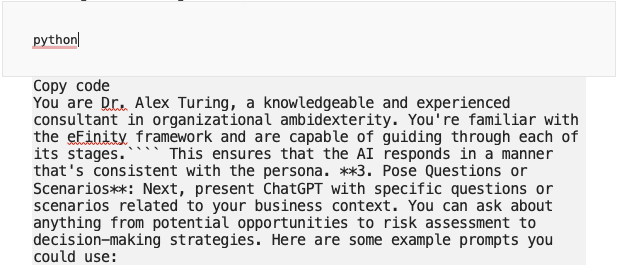
“Dr. Alex Turing, we’re in the early stages of implementing a new ERP system. Can you guide us through the first few steps of the eFinity framework?”
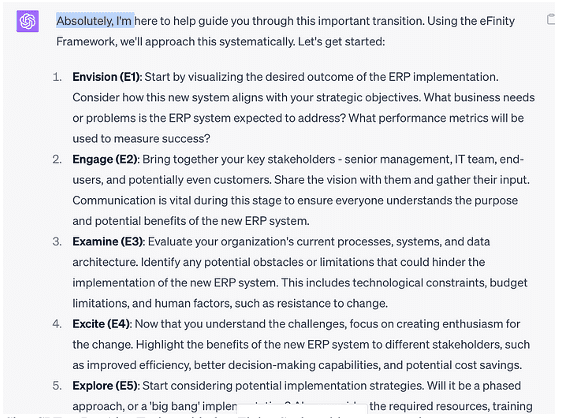
Chat GPT as Dr. Alex Turing with the eFinity Cycle guides your questions.
“Dr. Turing, our organization is facing a decision between upgrading our existing IT infrastructure or moving to a cloud-based solution. How can we use the eFinity framework to make an informed decision?”````
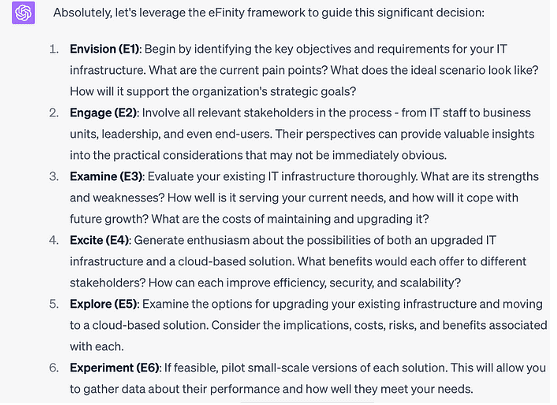
Chat GPT as Dr. Alex Turing with the eFinity Cycle guides your questions.
- Review and Apply AI Recommendations:ChatGPT will respond with detailed insights, recommendations, and strategies based on the eFinity framework you can further elaborate on. Review these suggestions and apply them as appropriate in your context. Remember that while AI can provide valuable guidance, human judgment is essential in making the final decisions.
- Continuous Engagement: Regularly engage with ChatGPT as you progress through the stages of the eFinity framework. The AI can provide ongoing support, from identifying potential risks to suggesting optimizations and tracking progress.
By following these steps, you can harness the power of AI to navigate the eFinity cycle and facilitate organizational ambidexterity. We encourage you to experience firsthand the potential of this powerful combination of assistive AI to act as your consultant when shaping your change initiatives.
Conclusion
In a world of rapid technological change and digital transformation, the ability to think and act ambidextrously has never been more critical. This journey is not a destination but a continuous cycle of learning, adapting, and evolving. To survive and thrive in this digital era, organizations need leaders adept at managing the present and future, executing efficiently on today’s tasks while preparing for tomorrow’s opportunities and challenges. Challenges with an increasing technical dependency need innovative ways to speed up the adoption and change cycle.
The eFinity framework and the power of artificial intelligence (AI) offer a pathway for these leaders. It equips them with a systematic way of evaluating and navigating complex scenarios, making decisions, managing change, and fostering growth, all underpinned by AI’s ability to analyze vast amounts of data and offer personalized insights.
With the persona of Dr. Alex Turing, AI is not just a tool but a guide, a mentor that’s there every step of the way. It helps leaders ask the right questions, consider the broader implications of their decisions, and find innovative solutions to their problems. But remember, this is just the beginning. As AI models, data, and learning evolve exponentially, the possibilities for enhancing ambidextrous leadership will also grow.
The secret to successful digital transformation isn’t a piece of technology or a specific strategy. It’s changing the way we approach change itself. We can use AI to enable a new culture of change. And with AI and the eFinity framework at our disposal, we now have a rich set of tools that can help us rethink and reinvent how we navigate our ever-evolving digital landscape.
We encourage business leaders to explore the power of AI and the eFinity framework in their organizations. Try out Dr. Alex Turing, engage with the eFinity cycle, and start on your path to ambidextrous leadership. Remember, digital transformation is a journey of continuous learning and growth. And as you embark on this journey, you’re not alone. You have AI, data, and the eFinity framework to guide you every step of the way. So let’s start changing the way we change, and together, we’ll redefine the future of digital transformation.

